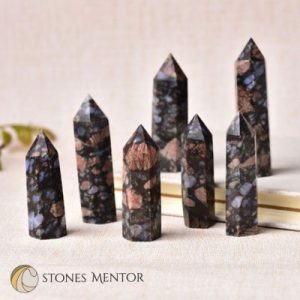What’s Amphibole Quartz: Its Properties, Formation, and Uses


Amphibole Quartz is a unique and fascinating mineral prized by collectors, gemologists, and jewelry makers. This article will explore the properties, formation, and uses of this magical quartz, providing readers with a comprehensive understanding of this intriguing mineral.
What is Amphibole Quartz?
Amphibole Quartz is a type of stone that is characterized by the presence of amphibole inclusions. Amphiboles are a group of minerals that include hornblende, tremolite, actinolite, and others. These minerals are typically found in metamorphic and igneous rocks, and their inclusions in quartz can produce a variety of colors and patterns.
Uses of Amphibole Quartz:
Amphibole Quartz has a variety of uses in jewelry, lapidary, and metaphysical applications. Here are some of the most common usages of This Quartz:
Jewelry:
Amphibole Quartz is often used in jewelry due to its unique patterns and colors. It can be cut and polished into cabochons, beads, and faceted stones and is usually set in sterling silver or gold.
Lapidary:
This quartz is a popular material for lapidary work, including carving, sculpting, and polishing. It can be shaped into various forms, including spheres, obelisks, and pyramids.
Metaphysical Properties:
Amphibole Quartz is believed to have various metaphysical properties, including the ability to enhance intuition, promote emotional healing, and stimulate creativity. Therefore, it is often used in meditation and energy-healing practices.
Formation of Amphibole Quartz:
This quartz is typically formed through a process of metamorphism or hydrothermal alteration. During these processes, minerals such as hornblende, tremolite, and actinolite are incorporated into the quartz matrix, creating the distinctive patterns and colors of this Amphibole Quartz.
Properties of Amphibole Quartz:

Amphibole Quartz has a wide range of physical and chemical properties, making it a unique and valuable mineral. Here are some of the most important properties of this magical quartz:
Color:
This magical quartz can have a wide range of colors, including white, gray, green, pink, and brown. In addition, the type of amphibole inclusion present often determines the color of the mineral.
Clarity:
Amphibole Quartz can be transparent, translucent, or opaque, depending on the amount and type of inclusions present.
Hardness:
This quartz has a hardness of 7 on the Mohs scale, which makes it a durable and scratch-resistant mineral.
Specific Gravity:
The specific gravity of This Quartz ranges from 2.65 to 2.91, which is similar to other types of quartz, such as Blue Rose Quartz or Aura Quartz, etc.
Other Properties Of Amphibole Quartz:
This magical quartz may exhibit chatoyancy (cat’s eye effect), asterism (the star effect), or iridescence (rainbow effect), depending on the type and arrangement of inclusions.
Conclusion:
In conclusion, This Quartz is a fascinating and unique mineral that has captured the attention of gemologists, collectors, and metaphysical practitioners alike. Its distinctive patterns and colors, as well as its physical and metaphysical properties, make it a valuable and sought-after material. So, whether it is used in jewelry, lapidary, or spiritual practices, Amphibole Quartz is sure to leave a lasting impression.
I hope you found this article helpful
FAQs: (Frequently Asked Questions)
Q: What are the most common colors of Amphibole Quartz?
Ans: This quartz can be found in a wide range of colors, including white, gray, green, pink, and brown.
Q: Where is Amphibole Quartz found?
Ans: This Quartz is found in many locations around the world, including Brazil, Madagascar, Austria, and the United States.
Q: How is Amphibole Quartz used in energy healing?
Ans: This magical quartz is believed to have a variety of metaphysical properties, including the ability to enhance intuition, promote emotional healing, and stimulate creativity. It can be used in meditation, placed on the body during energy healing sessions, or carried as a talisman.
Q: Is Amphibole Quartz rare?
Ans: This Quartz is not considered a rare mineral, but high-quality specimens with unique patterns and colors can be quite valuable.
Q: Can Amphibole Quartz be treated or enhanced?
Ans: This Quartz is not typically treated or enhanced. Still, like all gemstones, purchasing from a reputable dealer who can provide information about the stone’s origin and treatment is important.



